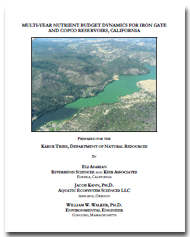New Science Documents
Scientific knowledge of Klamath River water quality, nutrient pollution processes, fish health and the role played by Klamath Hydroelectric Project reservoirs has increased rapidly since the KHP relicensing process began in February 2004. Learn about the health risks posed by a toxic blue-green algae and its potential effects on Tribes and the Lower Klamath River.
Text blocks below citations are excerpts.
Toxic Algae and Microcystis
Kann, J., L. Bowater and S. Corum. 2010. Middle Klamath River Toxic Cyanobacteria Trends, 2009. Aquatic Ecosystem Sciences LLC. and Karuk Tribe Department of Natural Resources. 25 pp.
Middle Klamath River sampling in 2009 continued to show widespread and high abundance of toxigenic MSAE from July-September, exceeding public health thresholds by numerous times during these months. River stations downstream from Copco and Iron Gate Reservoirs showed levels of both MSAE and microcystin toxin that were lower relative to the reservoir stations; however, on numerous occasions river samples taken in the mixed portion of the channel exceeded the threshold guideline values of 40,000 cells/ml MSAE or 8 μg/L microcystin. Similar to 2008, samples taken in areas of low velocity in Klamath River edge habitat in 2009 showed that MSAE cell density and microcystin concentration were often higher than the open water samples, and more frequently exceeded the 40,000 cells/ml MSAE and 8 μg/L microcystin public health guideline values. Public health exceedances were typically highest at Brown Bear (BB), but a microcystin value of 1700 μg/L was observed at KRBI on 8/3/2009. As in 2008, from a public health perspective these data illustrate that low MSAE or toxin values in open-water (collected in mixed areas of higher velocity) Klamath River samples often translates to values exceeding public health thresholds in river-edge areas.
For information on Microcystis/microcystin in Iron Gate and Copco reservoirs in 2005-2008, see Kann and Corum (2006), Kann and Corum (2007), and Kann, J. and S. Corum (2009).
Kann, J. 2008. Microcystin Bioaccumulation in Klamath River Fish and Freshwater Mussel Tissue: Preliminary 2007 Results. Aquatic Ecosystem Sciences LLC, Ashland, OR. 48 p.
This memorandum provides a preliminary presentation of microcystin tissue analyses performed … on Klamath River fish and freshwater mussels in 2007 … Microcystin analyses were performed on composite (consisting of 6 yearling fall Chinook) liver, stomach, and fillet samples collected from the Iron Gate Hatchery … , a composite mussel sample … collected from the Klamath River in the Seiad Valley area… ; individual Klamath River mussel samples… ; and yellow perch (both individual fillets and liver composites) collected from Copco and Iron Gate Reservoirs...
Tissue concentration results for various microcystin congeners showed some level of bioaccumulation in the majority (85%) of samples tested in July and September. … Evaluation of bioaccumulation in yellow perch fillets and freshwater mussels with respect to public health guidelines indicates that all TDI guideline levels as defined by Ibelings and Chorus (2007) were exceeded to varying degrees in tested Klamath River organisms, including several observations of values exceeding Acute TDI thresholds ... In light of these bioaccumulation data, public health advisories should include warnings for ingestion of fish and freshwater mussels
Yurok Tribe Environmental Program. 2008. Final 2007 Klamath River Blue-Green Algae Summary Report. By Ken Fetcho, Yurok Tribe Environmental Program, Klamath, California. 27 pp.
Microcystis aeruginosa (MSAE) was first detected on July 24th, 2007 at the Klamath River at Weitchpec sampling site. MSAE continued to be present in the Klamath River at multiple monitoring sites through October 2, 2007.
These results indicate that MSAE was present in the Klamath River within the Yurok Indian Reservation (YIR) for over two months, with cell density and microcystin levels peaking near the middle of September. The timing is of significance because of the presence of adult salmon and steelhead migrating upstream during this time period. This is also a time of increased cultural and recreational use of the Klamath River by both Tribal Members and sport fishermen.
For information on Microcystis/microcystin in the YIR in 2005 and 2006, see Fetcho (2006) and Fetcho (2007).
Nutrient Loading
Asarian, E. J. Kann, and W. Walker. 2010. River Nutrient Loading and Retention Dynamics in Free-Flowing Reaches, 2005-2008. Final Technical Report to the Yurok Tribe Environmental Program, Klamath, CA. 59pp + appendices.
Mass-balance nutrient budgets were constructed and summarized on seasonal time scales (June 1 - October 20 and July 1 - September 30) to assess temporal nutrient dynamics and the relative fate of nutrients in each of the assessed river reaches. These analyses indicate that large quantities of nitrogen and phosphorus are retained when longer river lengths were considered. For example, the Iron Gate nutrient load was reduced by 24% for total phosphorus (TP), 25% for soluble reactive phosphorus (SRP), 21% for particulate phosphorus (PP), 41% for total nitrogen (TN), 93% for total inorganic nitrogen (TIN), and 21% for organic nitrogen (ON) during July- September 2007-2008 in the 130 miles from Iron Gate to Orleans.
To provide a range of estimates for how TP and TN concentrations at Iron Gate Dam might change under a dam removal scenario, relative retention rates in river reaches were compared with results from a study of the Copco-Iron Gate Reservoir complex by Asarian et al. (2009). The results of this analysis indicate that dam removal will result in only a very small increase in TP concentration in the Klamath River between Iron Gate and Turwar. TN concentrations will increase more than for TP, although the magnitude of the increase diminishes with increasing distance downstream of Iron Gate. The effect is substantially diminished by Orleans and quite small at Turwar. Although estimated nutrient concentrations are predicted to increase in the mainstem Klamath River downstream of the dams following dam removal, the resulting effects on algal and macrophyte growth are complex and may vary by reach.
Asarian, E. J. Kann, and W. Walker. 2009. Multi-year Nutrient Budget Dynamics for Iron Gate and Copco Reservoirs, California. Prepared by Riverbend Sciences, Kier Associates, Aquatic Ecosystem Sciences, and William Walker for the Karuk Tribe Department of Natural Resources, Orleans, CA. 55pp + appendices.
Based on mass-balance nutrient budgets, the combined retention of Iron Gate and Copco Reservoirs was 9±4% of TP inflow over the entire 31-month study period (May 2005-December 2007). During the main reservoir phytoplankton growing season (May 18-September 30) the total combined TP retention was -8%, while for the period encompassing turnover (May 18-December 11) it was 0%. The relatively low TP retention during the growing season period is likely due to a combination of two factors: 1) a high percentage of the incoming phosphorus load was in dissolved form, which is less likely to settle than particulate phosphorus, and 2) in many reservoirs, internal phosphorus loading commonly occurs during the type of low and prolonged dissolved oxygen conditions observed in this study.
Over the entire study period (May 2005-December 2007), the combined retention of Iron Gate and Copco Reservoirs was 13±3% of TN inflow. For the main reservoir phytoplankton growing season (May 18-September 30) total combined TN retention was 23%, while for the period encompassing turnover (May 18-December 11) it was 15%. Higher percent retention during summer months may reflect settling of inflow organic matter and in-reservoir algal material, and/or denitrification.
Overall net retention accounted for a relatively low (11% for TP, and 12% for TN) percentage of inflow on an annual basis. However, these observed values were generally within the range predicted using models developed from a broad range of lakes and reservoirs that incorporate inflow loading and other hydraulic characteristics.

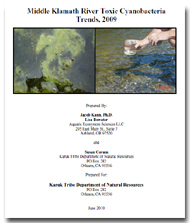 Kann, Bowater and Corum 2010
Kann, Bowater and Corum 2010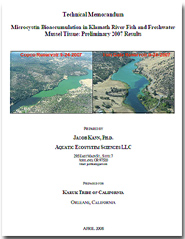
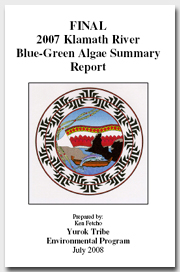
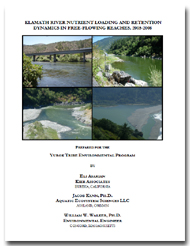 Asarian, Kann and Walker 2010
Asarian, Kann and Walker 2010 